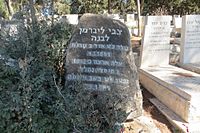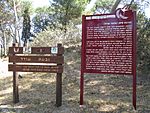Zvi Lieberman facts for kids
Zvi Lieberman (also Zvi Liberman) (Hebrew: צבי ליברמן) (March 1, 1891 - August 6, 1985) was an Israeli author who wrote many books for children. He was born in Russia and later moved to Palestine (which is now Israel) during a time called the Second Aliyah. He helped to start a community called Moshav Nahalal. Two important Israeli movies, "Oded the Wanderer" (1933) and "Over the Ruins" (1938), were based on his books.
Contents
Who Was Zvi Lieberman?
Zvi Lieberman was born in a village called Mankivka in Ukraine. He grew up in a traditional Jewish home and went to a religious school called a heder, and later a yeshiva. He also studied other subjects with a private teacher. His father, Ben-Zion, was a businessman who was known for his knowledge of Hebrew. From a young age, Zvi was very interested in Zionism, which is the idea of a Jewish homeland in Israel, and he joined a Zionist youth group.
Moving to Palestine
In 1912, Lieberman moved to Palestine as part of the Second Aliyah, a wave of Jewish immigration. He worked hard as a farmer and laborer in places like Hadera, Gan Shmuel, Degania Alef, and Sejera. In 1921, he became one of the first people to help build Nahalal, where he lived for the rest of his life.
His Family Life
Lieberman married Rivka Pinski. Their first daughter, Heftsiba, sadly passed away as a baby. They had four more children: Sarah, Rachel, Oded, and Dina. The character "Oded" in Lieberman's famous book Oded Ha-noded was named after his son. A hill near Ramat David was later named Givat Oded in his son's honor.
Helping to Build the Country
Zvi Lieberman was very active in public life, helping to build the new Jewish community in Palestine.
Working for the Community
During the First World War, Lieberman led the employment office for a workers' group called Hapoel Hatzair. In 1916, he helped create Hamashbir Hamerkazi, a group that helped people get goods at fair prices. From 1919 to 1925, he helped organize immigration for the Histadrut, a big labor organization. He also worked with the Jewish National Fund and the Jewish Agency, which were important groups for developing the land and helping new immigrants.
Representing Workers
In 1935, Lieberman was chosen to go to the 19th Zionist Congress in Lucerne, Switzerland, as a representative for the Labor movement. He was also an active member of groups like the Farmers Association, the Israel Naval Society, and the Moshavim Movement, which supported the cooperative farming communities.
Writing and Journalism
Lieberman started writing when he was still in Ukraine, but he left all his early writings behind when he moved to Palestine. His first published story appeared in Gan Yerek, a journal that later became the newspaper for Hapoel Hatzair. This first article was about bee-keeping among the Yemenite Jewish community. For many years, he wrote articles and commentary for the Davar newspaper and Hapoel Hatzair.
Writing for Young Readers
In 1932, Lieberman began writing for children. He started with paperback books like Oded the Wanderer and later wrote hardcover books. He wanted to offer children in Palestine good quality Hebrew books, different from the cheaper books available at the time. Over the years, he published many picture books, fiction for teenagers, and novels. He also wrote serious research for adults. The famous Israeli writer Amos Oz mentioned in his book A Tale of Love and Darkness that he read Lieberman’s book Over the Ruins many times as a child and it made a big impact on him.
Lieberman's Books on Screen
Two of Zvi Lieberman's books were made into important films in Israeli cinema history.
Oded the Wanderer Film
In 1933, Oded ha-noded (Oded the Wanderer) became a silent film. It was the first full-length movie made for children in the country. It was made with very little money. In the movie, Oded is a young Israeli-born boy who goes on a hike with his school friends. He gets lost when he wanders off to write about the beautiful scenery. After a week, he finds an Arab village, teaches the people there to read and write, and eventually finds his way home.
Over the Ruins Film
Another book by Lieberman, Me’al ha-khoravot (Over the Ruins), was made into a 70-minute film in 1938. This movie had sound and dialogue, and Lieberman himself wrote the screenplay. The film was about children in a Jewish village in the Galilee during the Second Temple period, whose parents were killed by the Romans. The children work together to rebuild their village. Even though it didn't do well at the box office, it is still considered a very important film in the history of Israeli movies.
Themes in His Books
Lieberman wrote for children and young adults about many different topics.
Life in Early Israel
Some of his books are about life in the kibbutz (a communal farm) and moshav (a cooperative farming village), like the story of Oded, the boy who gets lost while hiking. Other stories are about figures from the Bible or about Jewish life during the First and Second Temple periods. His novel From Babylonia to Jerusalem (1933) compared the return of Jews from Babylon long ago to the new waves of immigration to Palestine.
Future and Imagination
Lieberman also wrote utopian novels, which are stories about perfect societies. For example, Khalom ha-shlosha (The Dream of Three) is about three friends from the city of Safed. Two of them are focused on money or just having fun, but the third friend helps them change their lives by starting a socialist community.
Tevel betkhiyata (Renaissance of a Universe) (1955) was one of the first science fiction books written in Hebrew. It tells the story of a perfect society built by astronauts on a trip to Mars. Some of Lieberman’s books were also translated into English.
Published Works
- Ha-dayagim ha-ktanim, 1932 (Hebrew)
- Oded ha-noded, 1932 (Hebrew)
- Ha-Dayagim ha-Ktanim, 1932 (Hebrew)
- From Babylonia to Jerusalem, 1933 (English, Hebrew)
- Aleelot Pooty, 1933 (Hebrew)
- Khalom ha-shlosha, 1934 (Hebrew)
- Yaldei ha’emek, 1936 (Hebrew)
- Givat ha-yeladim'’, 1936 (Hebrew)
- Me’al ha- khoravot'’, 1938 (Hebrew)
- Lost on Mount Tabor, in Sabra Children: Stories of Fun and Adventure in Israel , 1940 (English)
- Masa’ay Zizi hagamad’,’ 1942 (Hebrew), illustrated by David Gilboa
- Dina veta’aluleha, 1945 (Hebrew)
- Nifgeshu bamoledet, 1945 (Hebrew)
- Amikhai, yedid kol khai, 1950 (Hebrew)
- Nehemia: Sipur histori , 1950 (Hebrew)
- Avital ve-Zalzal, 1951 (Hebrew)
- Beharei yerushalayaim, 1953 (Hebrew)
- David veyonatan: Sipur livnei no’ar, 1954 (Hebrew)
- Tevel betkhiyata, 1955 (Hebrew)
- Arba’a malakhim, 1955 (Hebrew)
- Gad vehagamad, 1956 (Hebrew)
- Yair ha-giladi, 1957 (Hebrew)
- Ha-yeled Khai vehakhamor Ashmodai, 1957 (Hebrew)
- Shimshon ba’al ha-khalomot, 1957 (Hebrew)
- Hanna veshiva baneha, 1958 (Hebrew)
- Makhbo’im, 1958 (Hebrew)
- Ha-gamadim ha-adumim, 1959 (Hebrew)
- Ma’ayanot: Sipur mekhayeh ha-moshav ha-rishon be-Eretz Yisrael, 1961 (Hebrew)
- Nekhalei Akhzav, 1963 (Hebrew)
- Ha-nesher ha-gadol, 1964 (Hebrew)
- Harpatka’otav shel Dan, 1964 (Hebrew)
- Gidon vekhaverav, 1964 (Hebrew)
- Khayeh akhat khalutzah: Sipur khayeha shel Rivka Livneh Liberman le-vet Pinski, 1964 (Hebrew)
- Bishleekhut kalkalit: Khevrat Ampal, koroteha u-pe’ala, 1964 (Hebrew)
- Givat avanim: Sipur, 1965 (Hebrew)
- Jewish Farmers in Russia Fields, 1965 (Hebrew, English)
- Ikarim yehudim be-rusiya: Skira historit al khakla’im be-rusiya mishnat 1807 (Jewish Agriculturalists on the Russian Steppes), 1965 (Hebrew)
- David ve-Aminadav: Sipur histori mitekufat Shaul ve-David, 1966 (Hebrew)
- Ha-kana’im ladror: Roman histori mitkufat Bar Kokhba, 1966 (Hebrew)
- The Children of the Cave: A Tale of Israel and Rome, 1969 (Hebrew, English)
- Ha-khamisha, 1969 (Hebrew)
- In the Beginning: The Story of Abraham, 1969 (English)
- Avram ha-ivri, 1973 (Hebrew)
- Misipurei hakhevraiya, 1973 (Hebrew)
- Bein sadeh veya’ar, 1974 (Hebrew)
- Moshe, 1977 (Hebrew)
- Betzel ha-ikaliptus, 1978 (Hebrew)
- Khalomot uma’asim, 1978 (Hebrew)
- Mikhayay hapo’alim be-Hadera, 1912-1920, 1983 (Hebrew)
- Sivan bakaiyitz uvkhoref, 1998 (Hebrew)
- Meir Schnitzer, Israeli Cinema, Kinneret, 1994, pp. 16, 23, 30, 32, 37.
- Amy Kronish, Israeli Film: A Reference Guide, Greenwood Publishing, 2003, p. 107



